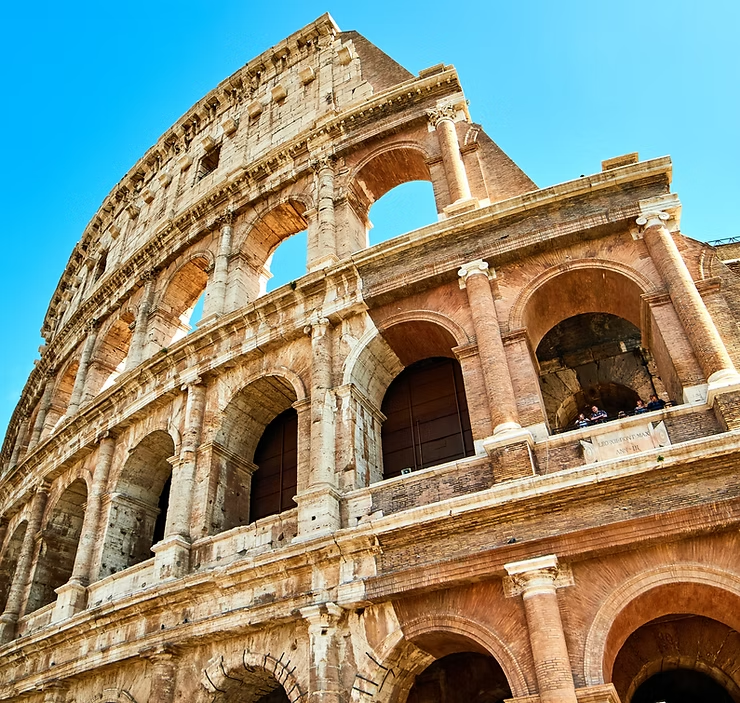
Rome
Explore Rome
Rome
Rome: The Eternal City of History, Culture & Cuisine
Rome is a city where ancient history, world-class art, and vibrant modern life blend seamlessly. From the grandeur of the Colosseum to the Vatican’s breathtaking treasures and the charming cobblestone streets of Trastevere, Rome offers a perfect mix of history, culture, and romance. Whether you're tossing a coin into the Trevi Fountain, savoring authentic pasta, or admiring Michelangelo’s masterpieces, Rome is a must-visit destination for history lovers, foodies, and adventure seekers alike.
Frequently Asked Questions: Rome
Rome’s Mediterranean climate makes it a great year-round destination, but some seasons are better than others:
- March–May (Spring): Best for mild temperatures, blooming gardens, and fewer crowds.
- June–August (Summer & Peak Season): Ideal for long sightseeing days, warm weather, and lively piazzas.
- September–November (Fall): Great for comfortable weather, food festivals, and fewer tourists.
- December–February (Winter & Holiday Season): Best for Christmas markets, festive lights, and fewer crowds at major attractions.
- Colosseum & Roman Forum – The iconic amphitheater where gladiators once battled and the ruins of ancient Rome’s political center.
- Vatican City & St. Peter’s Basilica – The world’s smallest country, home to Michelangelo’s Sistine Chapel and the Pope.
- Pantheon – A remarkable 2,000-year-old temple with a stunning domed ceiling.
- Trevi Fountain – Toss a coin in to ensure your return to Rome.
- Piazza Navona – A beautiful square filled with fountains, artists, and cafés.
- Spanish Steps – Climb Rome’s most famous staircase for a great city view.
- Trastevere Neighborhood – A charming area known for its cobblestone streets and authentic Roman cuisine.
- Villa Borghese & Borghese Gallery – A beautiful park with an impressive collection of Renaissance art.
- Castel Sant’Angelo – A fortress with panoramic views of the city and the Tiber River.
- Mouth of Truth (Bocca della Verità) – A legendary stone carving said to bite the hands of liars.
- Cacio e Pepe – A classic Roman pasta dish made with pecorino cheese and black pepper.
- Carbonara – Creamy pasta made with eggs, pancetta, and Pecorino Romano cheese.
- Amatriciana – Tomato-based pasta with guanciale (cured pork cheek) and pecorino cheese.
- Supplì – Crispy-fried rice balls stuffed with mozzarella, similar to Sicilian arancini.
- Carciofi alla Romana – Roman-style artichokes braised with garlic and mint.
- Porchetta – Slow-roasted, herb-seasoned pork, a favorite street food.
- Pizza al Taglio – Rome’s famous rectangular pizza, sold by weight.
- Maritozzo – A sweet brioche bun filled with whipped cream.
- Gelato – Creamy Italian ice cream, best enjoyed from traditional gelaterias.
- Espresso & Tiramisu – The perfect way to end a Roman meal.
- Flights: Arrive at Leonardo da Vinci International Airport (FCO) or Ciampino Airport (CIA).
- Metro & Public Transport: Rome’s metro, buses, and trams connect major sites, but walking is often the best way to explore.
- Taxis & Ride-Hailing Apps: Taxis are available, but Uber is limited in Rome.
- Walking: Many of Rome’s landmarks are within walking distance of each other.
- Hop-On Hop-Off Buses: A convenient way to see major attractions in a short time.
- Train (Termini Station): Ideal for day trips to Florence, Naples, or Pompeii.
- For U.S. travelers: No visa required for stays up to 90 days, but a valid passport is necessary.
- For international travelers: Check Italy’s Schengen visa requirements based on nationality.
- EU Travelers: Can enter freely with a valid national ID or passport.
- Currency: Euro (€ EUR).
- Credit cards are widely accepted, but small trattorias and markets may prefer cash.
- ATMs are available throughout the city, offering good exchange rates.
- Currency exchange is available at airports, banks, and exchange offices.
- Italian is the official language.
- English is widely spoken in tourist areas, hotels, and restaurants.
- Learning basic Italian phrases like “Grazie” (Thank you) and “Buongiorno” (Good morning) is appreciated.
- Greet with “Buongiorno” (Good morning) and “Grazie” (Thank you).
- Dining etiquette: Don’t order cappuccino after 11 AM—Romans prefer espresso after meals.
- Dress modestly when visiting churches – Shoulders and knees should be covered.
- Tipping is not mandatory, but rounding up or leaving 5-10% is appreciated.
- Avoid touching historic monuments and artifacts – Preservation is highly respected.
- Rome has a relaxed pace—embrace the Italian “la dolce vita” lifestyle.
- Restaurants: 5–10% tip is common if a service charge isn’t included.
- Bars & Cafés: Rounding up the bill is appreciated.
- Hotels: €1–2 per bag for bellhops, €2–5 per night for housekeeping.
- Taxis: Tipping is not required, but rounding up is polite.
- Tour Guides & Excursions: €5–10 per person for excellent service.
- For peak season (June–September & Christmas holidays): Book 6–12 months in advance for hotels and flights.
- For off-season travel (October–April): Booking a few weeks ahead is usually fine.
- For major attractions like the Vatican & Colosseum: Book tickets online at least a few weeks in advance.
- No COVID-19 test is required for entry, but check for updates before traveling.
- Some attractions require timed-entry tickets—book online in advance.
- Rome’s traffic is heavy—walking or using public transport is often faster than driving.
Contact us at281-229-0862 or admin@pointmetoparadise.com
